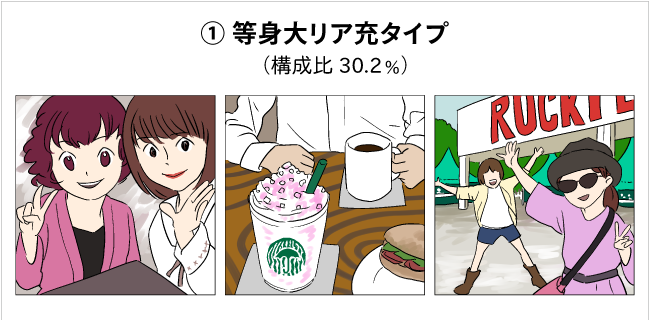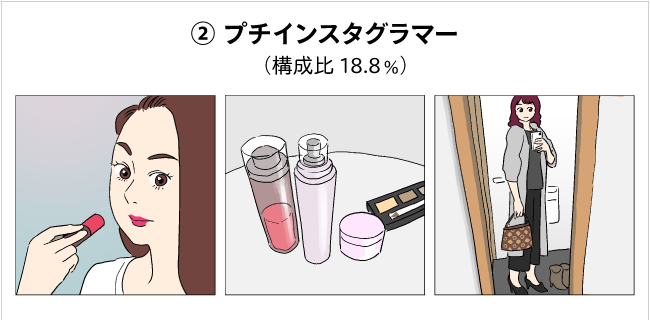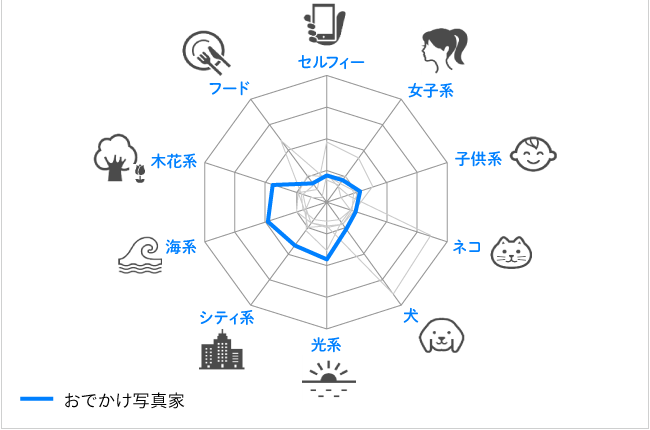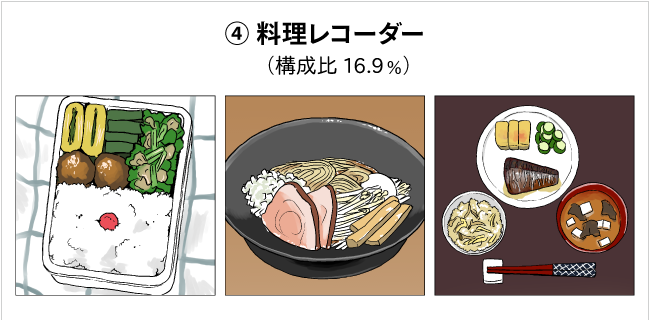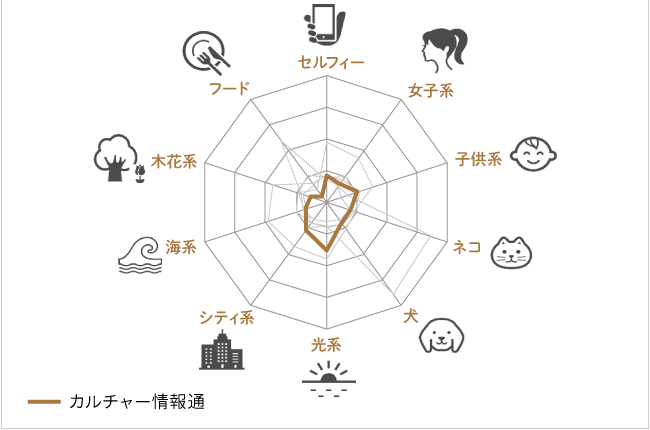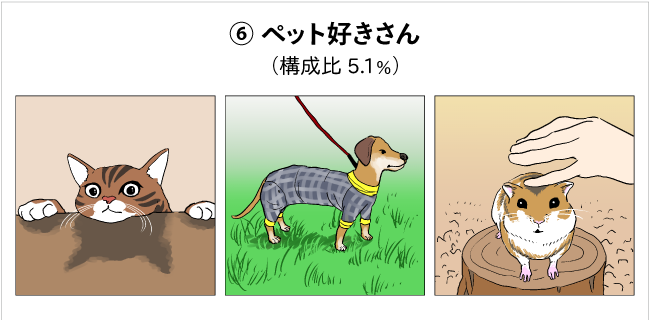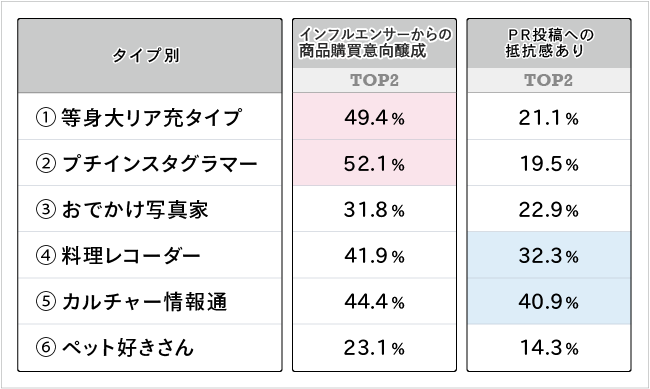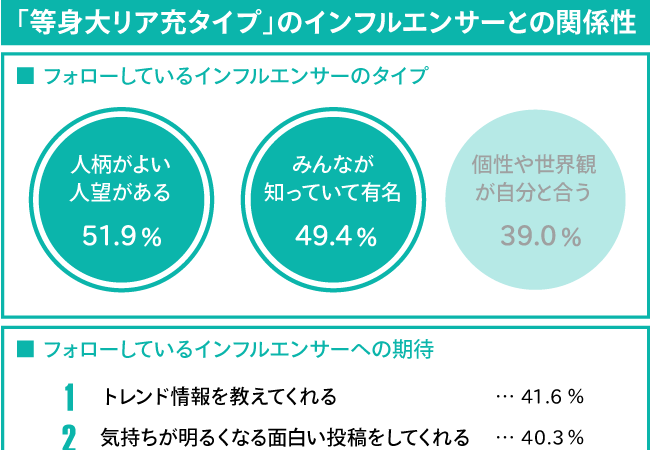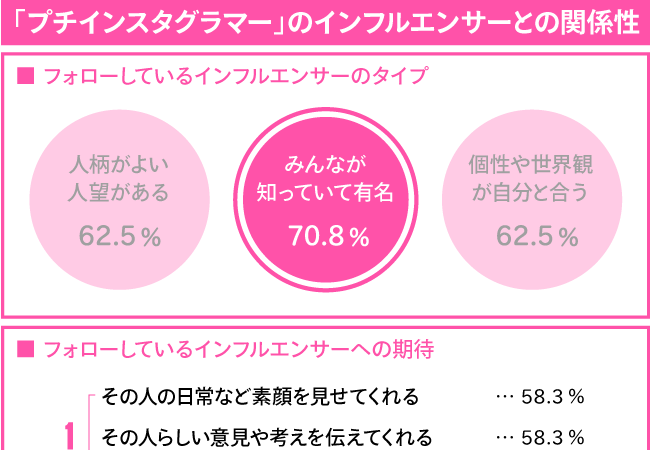In Part 2, we classified influencer types and clarified their differing levels of influence on purchasing behavior and resistance to PR posts. But who exactly are the influencer fans* who are influenced by these influencers?
Part 1 already provided an overview of influencer fans based on several data points. Notably, teenage girls are strongly influenced at every stage of the purchase funnel, from "building familiarity" to "product purchase."
However, the effectiveness of influencer-based promotions extends beyond simply boosting product awareness and purchase intent among influencer fans.
For example, influencer PR posts can spark word-of-mouth discussions about products or generate interactions between influencers and fans. Additionally, such campaigns often encourage fans to post on social media. Therefore, understanding how influencer fans typically use social media is crucial.
Consequently, we analyzed Instagram photos (the most recent 11 posts) from 250 influencer fans (both men and women) and categorized them into types based on the similarity of their posts.
* Criteria for "Influencer Fans"
・Views at least one major SNS platform once a day
・Recognizes "influencers" (not just the term, but at a level of "vaguely understanding the concept")
・Views influencers' pages or videos at least once a week
・Have shown interest in products or services introduced by the "influencer"
Six Types of Influencer Fans
This survey categorized Instagram users who are influencer fans into 6 distinct types, analyzing their attributes and relationship with influencers. Post content used for categorization was grouped into 10 categories* based on similarity, with their composition shown in a radar chart.
*In addition to selfies, cats, dogs, beach-related, and food, the following five categories exist:
・"Girls' Style": Hairstyles, hair color, long hair, girls, etc.
・"Kids-themed": Children, toddlers, toys, etc.
・"Light-themed": Evening, sunlight, night, light, illumination, etc.
・"City-themed": Landmarks, cityscapes, sky, blue, etc.
・"Flora & Nature": Flowers, trees, spring, nature, flora, etc.
Now, let's look at these 6 types—① Life-Size Real-Life Enthusiast, ② Mini Instagrammer, ③ Outing Photographer, ④ Food Recorder, ⑤ Culture Connoisseur, ⑥ Pet Lover—on a radar chart!
Don't you know people around you who fit these types?
We compared these six types in terms of their purchase intent formation—crucial for influencer marketing—and their resistance to PR posts.
Significant differences emerged between types, revealing varying affinities with influencer marketing. This article focuses on explaining the "Real-Life Enthusiast Type" and "Mini Instagrammer," who are particularly strongly influenced by influencers.
① Real-Life Happy Type
This represents the typical young Instagram user. It has the largest share among the six clusters, with a male-to-female ratio of 1:2. Their posts cover a wide variety of topics, not heavily skewed toward any specific genre.
Their hashtag usage trends show occasion-based hashtags (#lunch, #Christmas, etc.) and location/place name hashtags (#Tokyo, #Disneyland, etc.) ranking high, though none are overwhelmingly dominant. Conversely, community-based hashtags (e.g., #WantToConnectWith○○, #○○Club, etc., used to connect with peers within Instagram) are less common.
Posts don't seem to follow a set theme; they appear to be natural, spontaneous shares, like when going out with friends. It's likely Instagram is used as part of real-life communication with friends. Among monthly spending, the amount allocated to "events and festivals" is ¥8,227, the highest among the six types.
When following influencers, they prioritize two of the three influencer metrics ("3R") introduced in Part 2: having a good personality and being well-liked (Resonance) and being widely known and famous (Reach).
Regarding what they seek from influencers' posts, "providing trend information" (41.6%, +9.4 points above average) ranks highest.
② Mini-Instagrammers
Centered around female students around 20 years old. They show high interest in fashion and beauty, making them the type most aligned with the typical content categories imagined when thinking of "Instagrammers."
They are frequently asked by others for the latest information and have the highest average follower count among all types.
Occasion-related hashtags are their most frequent use, followed by brand-related ones (like cafes or clothing brands).
While they are fans of influencers, they also strongly identify as "information providers" themselves, much like influencers.
When it comes to influencers, they prioritize reach—being well-known and popular. This might reflect their own desire to become famous.
Expectations for influencer posts are consistently high across all categories. However, the areas showing the greatest deviation from the average are: providing trend information (54.2%, +22.0 points above average) and conveying personal preferences (52.1%, +19.1 points above average).
For Effective Influencer Marketing
In Part 2, we revealed that fans have different expectations depending on the influencer, and that the impact of PR posts also varies.
Furthermore, this article analyzed profiles for each type of influencer fan by cross-referencing survey data with Instagram post content. This revealed not only what fans expect from influencers and the impact they receive, but also their influence on social media and their hashtag usage tendencies.
Influencer fans are not only information recipients but also content creators. The insights gained here could potentially serve as hints for spreading word-of-mouth through influencers.
As outlined above, developing effective influencer strategies requires analysis from both the influencer's perspective and that of their target fans. Who are the influencers whose personas align with the product? Are their posts meeting expectations? What hashtags are most appropriate to use?
This requires not only accumulating data on influencers but also employing methods like social listening. Next time, we'll introduce the tools and techniques for this purpose.
[Survey Overview]
Survey Period: December 2017 - February 2018
Research Companies: Dentsu Macromill Insight, Inc., CrossRing
Research Method: Instagram data crawling, image analysis, and clustering
Sample Composition: 250 men and women aged 15–49 nationwide

